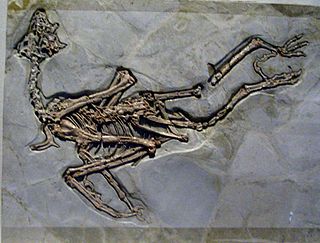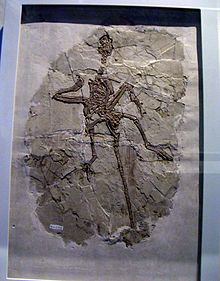
Caudipteryx is a genus of peacock-sized theropod dinosaurs that lived in the Barremian age of the early Cretaceous. They were feathered and extremely birdlike in their overall appearance, to the point that some paleontologists think it was a bird. Two species have been described: C. zoui, in 1998, and C. dongi, in 2000.

Maniraptora is a clade of coelurosaurian dinosaurs which includes the birds and the non-avian dinosaurs that were more closely related to them than to Ornithomimus velox. It contains the major subgroups Avialae, Deinonychosauria, Oviraptorosauria and Therizinosauria. Ornitholestes and the Alvarezsauroidea are also often included. Together with the next closest sister group, the Ornithomimosauria, Maniraptora comprises the more inclusive clade Maniraptoriformes. Maniraptorans first appear in the fossil record during the Jurassic Period, and survive today as living birds.

The Enantiornithes, also known as enantiornithines or enantiornitheans in literature, are a group of extinct avialans, the most abundant and diverse group known from the Mesozoic era. Almost all retained teeth and clawed fingers on each wing, but otherwise looked much like modern birds externally. Over eighty species of Enantiornithes have been named, but some names represent only single bones, so it is likely that not all are valid. The Enantiornithes became extinct at the Cretaceous–Paleogene boundary, along with Hesperornithes and all other non-avian dinosaurs.
Pedopenna is a genus of small, feathered, maniraptoran dinosaur from the Daohugou Beds in China. It is possibly older than Archaeopteryx, though the age of the Daohugou Beds where it was found is debated. A majority of studies suggest that beds probably date from between the late Middle Jurassic and early Late Jurassic Period.

Jinfengopteryx is a genus of maniraptoran dinosaur. It was found in the Qiaotou Member of the Huajiying Formation of Hebei Province, China, and is therefore of uncertain age. The Qiaotou Member may correlate with the more well-known Early Cretaceous Yixian Formation, and so probably dates to around 122 Ma ago.

Jeholornis is a genus of avialans that lived between approximately 122 and 120 million years ago during the early Cretaceous Period in China. Fossil Jeholornis were first discovered in the Jiufotang Formation in Hebei Province, China and additional specimens have been found in the older Yixian Formation.

Jixiangornis is a genus of basal avialans from the Early Cretaceous. Like later avialans, it had no teeth, but it also had a long tail, unlike modern birds. Since teeth were still present in some more derived short-tailed avialans, Jixiangornis seems to have evolved its toothlessness independently of modern birds. The long forelimb indicates at least some aerial ability. Jixiangornis is currently known only from a single specimen, a complete but juvenile skeleton. The fossil was found in the Yixian Formation near Beipiao City, western Liaoning, China.
Omnivoropteryx is a genus of primitive flying avialan from the early Cretaceous Upper Jiufotang Formation of China. The authors who described Omnivoropteryx, Stephen Czerkas and Qiang Ji, stated that their specimen closely resembles Sapeornis, but the pubis was longer and, since no skull was known for Sapeornis, they did not consider the two names synonyms. The later discovery of Sapeornis skulls shows that they were indeed similar to Omnivoropteryx. This may make Omnivoropteryx a junior synonym of Sapeornis, and the name may be abandoned.

Yandangornis is a genus of theropods from the Late Cretaceous. It lived 81.5 million years ago in what is now China. The type species, Y. longicaudus, was formally described by Cai and Zhou in 1999. The holotype specimen is a mostly complete skeleton in the collection of the Zhejiang Museum of Natural History, with accession number M1326. The fossil was discovered in 1986, near Linhai City in Zhejiang Province, China. It includes most of one complete skeleton. The genus was named after the Yandang mountains.

Sapeornis is a monotypic genus of avialan which lived during the early Cretaceous period. Sapeornis contains only one species, Sapeornis chaoyangensis.

Avialae is a clade containing the only living dinosaurs, the birds. It is usually defined as all theropod dinosaurs more closely related to birds (Aves) than to deinonychosaurs, though alternative definitions are occasionally used.

Confuciusornithidae is an extinct family of pygostylian avialans known from the Early Cretaceous, found in northern China. They are commonly placed as a sister group to Ornithothoraces, a group that contains all extant birds along with their closest extinct relatives. Confuciusornithidae contains four genera, possessing both shafted and non-shafted (downy) feathers. They are also noted for their distinctive pair of ribbon-like tail feathers of disputed function.

Omnivoropterygidae is a family of primitive avialans known exclusively from the Jiufotang Formation of China, though putative omnivoropterygids are known from the Maevarano Formation of the Maastrichtian of Madagascar. They had short skeletal tails and unusual skulls with teeth in the upper, but not lower, jaws. Their unique dentition has led some scientists to suggest an omnivorous diet for them. The family was named by Stephen A. Czerkas & Qiang Ji in 2002, though its junior synonym Sapeornithidae is often used instead, though it was named four years later in 2006. It is the only named family in the order Omnivoropterygiformes.
Sauriurae is a now-deprecated subclass of birds created by Ernst Haeckel in 1866. It was intended to include Archaeopteryx and distinguish it from all other birds then known, which he grouped in the sister-group Ornithurae. The distinction Haeckel referred to in this name is that Archaeopteryx possesses a long, reptile-like tail, while all other birds known to him had short tails with few vertebrae, fused at the end into a pygostyle. The unit was not much referred to, and when Hans Friedrich Gadow in 1893 erected Archaeornithes for basically the same fossils, this became the common name for the early reptile-like grade of birds.

Pygostylia is a group of avialans which includes the Confuciusornithidae and all of the more advanced species, the Ornithothoraces.
The Jiufotang Formation is an Early Cretaceous geological formation in Chaoyang, Liaoning which has yielded fossils of feathered dinosaurs, primitive birds, pterosaurs, and other organisms. It is a member of the Jehol group. The exact age of the Jiufotang has been debated for years, with estimates ranging from the Late Jurassic to the Early Cretaceous. New uranium-lead dates reveal the formation is deposited in the Aptian stage of the Early Cretaceous. Fossils of Microraptor and Jeholornis are from the Jiufotang.

Jeholornithidae is a family of avialan theropods whose taxonomy is controversial, whose remains are found in fossil deposits of what is now China. The controversy stems from whether most of the taxa in the group are just specimens of Jeholornis, as well as if the group is monophyletic at all. In the description of Kompsornis the authors Wang et al. (2020) found moderate support in the monophyly of the group, placing them as basal avialans sister to Pygostylia. No phylogenetic definitions for these groups were provided by Zhou and Zhang, but a topological definition was provided in 2020 by Wang and colleagues where Jeholornithiformes was defined as "the most inclusive clade containing Je. prima but excluding the extant birds".

Jinfengopteryginae is a subfamily of bird-like theropod dinosaurs known from the Cretaceous of Eurasia. This group includes relatively few genera, with members discovered in 2005 but the name erected in 2012. Like other troodontids, this group of dinosaurs resided in the Paraves potentially close to the Avialae.

Anchiornithidae is a family of eumaniraptorans which could be the basalmost family of birds in the clade Avialae. Anchiornithids have been classified at varying positions in the maniraptoran tree, with some scientists classifying them as a distinct family, a basal subfamily of Troodontidae, members of Archaeopterygidae, or an assemblage of dinosaurs that are an evolutionary grade within Avialae or Paraves.






























